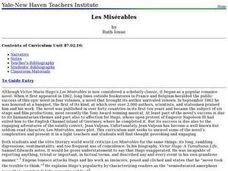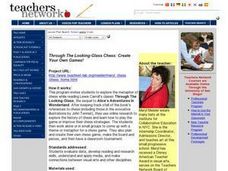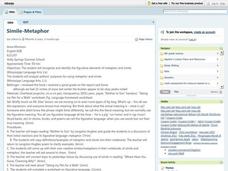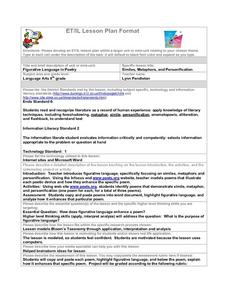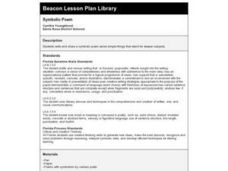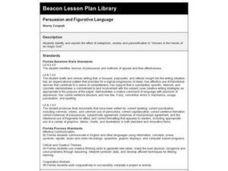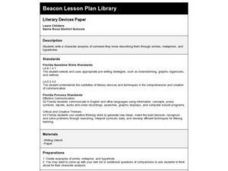Curated OER
Les Mis'rables
Students read, understand, and enjoy Les Miserables. They improve their skills in literary analysis, writing, and listening. Through the study of biblical and historical allusions, symbols, metaphors, and other figurative language, they...
Curated OER
Through the Looking-Glass Chess: Create Your Own Games!
Sixth graders research chess in relation to the metaphors in Lewis Carroll's Through the Looking-Glass. They read the novel and note references to chess and research the history of chess and how to play the game. In groups, they create...
Curated OER
Simile And Metaphor
Students engage in a lesson about metaphor and simile while using them in different contexts. They are asked to share some samples that are designed by them to other members of the class. Students practice writing them with the help of...
Curated OER
Cell and Compound Nouns
Students explore the definition and derivation of the popular usage of shorten compound nouns. Using worksheets and lecture materials, students provide meanings for the word "cell" when used in varying contexts. They also consider the...
Curated OER
Similes, Metaphors, and Personification
Eighth graders explore figurative language, specifically focusing on similes, metaphors and personification. They work on the web to identify poems that demonstrate simile, metaphor, and personification, then analyze how it enhances...
Curated OER
Metaphors, Personifications, Similes, and Hyperboles
Fourth graders discuss prior knowledge of the terms simile, hyperbole, metaphor, and personification. They then listen to the definitions of each and write a hyperbole, personification, simile, and metaphor to describe a Mr. Potato Head...
Curated OER
Fall Similes and Metaphors
Young scholars interpret what a similies and metaphors are. They give examples of similies and metaphors. Pupils write different similies and metaphors using fall or autumn descriptive words. Students base their comparisons on facts,...
Curated OER
Mixing Metaphors with Politics
Students discuss different literary devices and use them to write summaries of New York Times articles dealing with international news. They reflect on the effectiveness and appropriateness of sports metaphors in the political arena.
Curated OER
Figurative Language: Metaphors and Similes
Fifth graders are introduced to the figurative language using metaphors and similies. They identify the similarities and differences between the two and practice developing their own to use in their writing. They illustrate their...
Curated OER
Environmental Art
Students create their own environmental art after the teacher shows them a variety of example and has a discussion about it. They then write an initial personal definition of environmental art.
Curated OER
Figuratively Writing...It's for the Birds!
Learners identify and use literary devices such as personification, idioms, hyperbole, and metaphors. They identify one literary device and illustrate the meaning. They write a letter using correct letter format and incorporates literary...
Curated OER
Good Will - Three Chinese Stories
Students listen to The Seven Chinese Brothers and identify tall tale elements in it. They brainstorm ways they could help each other in school. They create a banner reflecting the style and art of Chinese decorations and clothing in the...
Curated OER
"Black Boy"
Students read a series of sentences and decide what literary term is being shown. They also discuss a novel about prejudice.
Curated OER
The Secret Garden
Students explore plants in science and England as they synthesize data from the book, "The Secret Garden in this twelve lessons unit. Comparisons between the nuturing needs of plants and humans are made.
Curated OER
Music from a Place Called Half Moon
Students read the novel, Music from a Place Called Half Moon. They are assigned chapters to analyze for literary elements and to assign titles to the book chapters.
Curated OER
Deciphering the Mechanics of Poetry
Eighth graders study poetic devices and use them in their own writing and apply them when reading poetry. In groups, they describe an item using poetic devices.
Curated OER
"How to Eat a Poem"
Eighth graders write a poem showing what they know about metaphors, and non-literal language to express ideas, convey meaning, and create images after they read Eve Merriam's "How to Eat a Poem".
Curated OER
Poetry: Techniques & Form
Ninth graders explore poetic technique and figurative language in this ten lesson plan unit. Comparisons are made between a variety of forms of poetic expressions and the lives of several poets are studied.
Curated OER
Figurative Language Academy Awards
Students examine figurative language in writing. Students demonstrate simile, metaphor, and personification in their own writing.
Curated OER
Mighty Metaphors
Fourth graders explore metaphors and then complete a worksheet on which they write metaphors. They may illustrate the metaphors.
Curated OER
The Nature of Haiku Poetry
Students brainstorm elements of nature art prints and photos. They identify the syllable count of Haiku and take a nature walk. They write Haiku poems while practicing the use of simile, alliteration, metaphor, and analogy to describe...
Curated OER
Symbolic Poem
High schoolers read and analyze several highly symbolic poems. They create their own symbolic poem, read it to the class, and discuss whether they can guess any hidden meanings.
Curated OER
Persuasion and Figurative Language
Students study and discuss definitions of metaphor, simile, and personification. In small groups, they read a section of "Sinners in the Hands of an Angry God" and identify those devices. The group presents their examples with the class.
Curated OER
Literary Devices Paper
Fourth graders write a character analysis of someone they know describing them through similes, metaphors, and hyperboles. They may include themselves and how their person relates to him or her.


